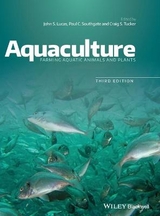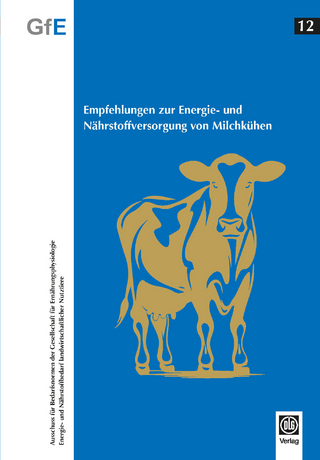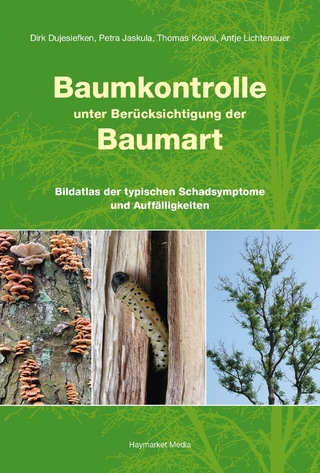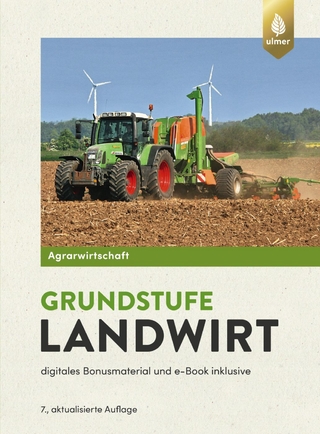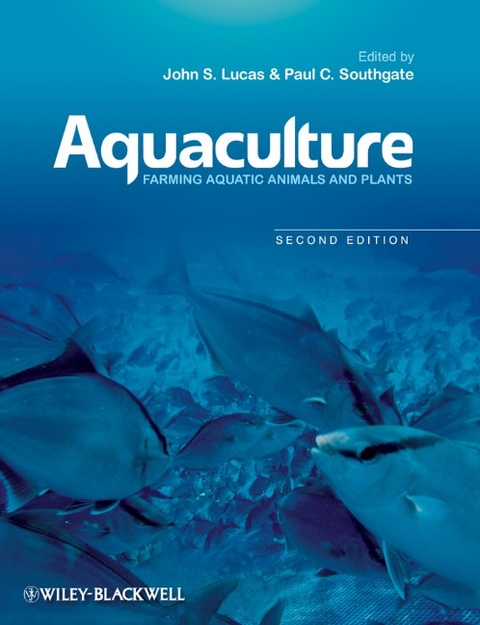
Aquaculture
Wiley-Blackwell (an imprint of John Wiley & Sons Ltd) (Verlag)
978-1-4051-8858-6 (ISBN)
- Titel ist leider vergriffen;
keine Neuauflage - Artikel merken
The output from world aquaculture, a multi-billion dollar global industry, continues to rise at a very rapid rate and it is now acknowledged that it will take over from fisheries to become the main source of animal and plant products from aquatic environments in the future. Since the first edition of this excellent and successful book was published, the aquaculture industry has continued to expand at a massive rate globally and has seen huge advances across its many and diverse facets. This new edition of Aquaculture: Farming Aquatic Animals and Plants covers all major aspects of the culture of fish, shellfish and algae in freshwater and marine environments. Subject areas covered include principles, water quality, environmental impacts of aquaculture, desert aquaculture, reproduction, life cycles and growth, genetics and stock improvement, nutrition and feed production, diseases, vaccination, post-harvest technology, economics and marketing, and future developments of aquaculture.
Separate chapters also cover the culture of algae, carps, salmonids, tilapias, channel catfish, marine and brackish fishes, soft-shelled turtles, marine shrimp, mitten crabs and other decapod crustaceans, bivalves, gastropods, and ornamentals. There is greater coverage of aquaculture in China in this new edition, reflecting China's importance in the world scene. For many, Aquaculture: Farming Aquatic Animals and Plants is now the book of choice, as a recommended text for students and as a concise reference for those working or entering into the industry. Providing core scientific and commercially useful information, and written by around 30 internationally-known and respected authors, this expanded and fully updated new edition of Aquaculture is a book that is essential reading for all students and professionals studying and working in aquaculture. Fish farmers, hatchery managers and all those supplying the aquaculture industry, including personnel within equipment and feed manufacturing companies, will find a great deal of commercially useful information within this important and now established book.
Reviews of the First Edition "This exciting, new and comprehensive book covers all major aspects of the aquaculture of fish, shellfish and algae in freshwater and marine environments including nutrition and feed production." International Aquafeed "Do we really need yet another book about aquaculture? As far as this 502-page work goes, the answer is a resounding 'yes'. This book will definitely find a place in university libraries, in the offices of policy-makers and with economists looking for production and marketing figures. Fish farmers can benefit greatly from the thematic chapters, as well as from those pertaining to the specific plant or animal they are keeping or intending to farm. Also, they may explore new species, using the wealth of information supplied." African Journal of Aquatic Science "Anyone studying the subject or working in any way interested in aquaculture would be well advised to acquire and study this wide-ranging book. One of the real 'bibles' on the aquaculture industry." Fishing Boat World and also Ausmarine
John Lucas is an Adjunct Professor in the Centre for Marine Studies, School of Biological Sciences, University of Queensland, Australia. Paul Southgate is Professor of Aquaculture in the School of Marine and Tropical Biology at James Cook University, Australia.
Preface to the Second Edition xiii Preface to the First Edition xiv List of Contributors xv 1 Introduction 1 John S. Lucas 1.1 What is aquaculture? 1 1.2 Origins of aquaculture and agriculture 2 1.3 Aquaculture and capture fi sheries production 4 1.4 The Blue Revolution 6 1.5 An allegory 11 1.6 Diversity of aquaculture 12 1.7 Stock enhancement 12 1.8 New developments in aquaculture 14 1.9 Conclusions 16 References 17 2 General Principles 18 Peter Appleford, John S. Lucas and Paul C. Southgate 2.1 Introduction 18 2.2 Structures used for aquaculture 18 2.3 Intensity of aquaculture 26 2.4 Static, open, semi-closed and recirculating (closed) systems 32 2.5 Plumbing and pumps 37 2.6 Site selection and development 42 2.7 Hatchery systems 44 2.8 Selecting a new species for culture 46 2.9 Developing a new cultured species 48 References 50 3 Water Quality 52 Claude Boyd 3.1 Introduction 52 3.2 Water quality variables 52 3.3 Effects of water quality on culture species 62 3.4 Water quality management 68 3.5 Effluents 80 3.6 Summary 81 References 82 4 Environmental Aspects 84 Martin Kumar and Simon Cripps 4.1 Public image 84 4.2 Impacts from land-based aquaculture 85 4.3 Impacts of aquaculture within large water bodies 91 4.4 General impacts on the environment 93 4.5 Impact assessment 99 4.6 Integrated wastewater treatment and aquaculture 101 4.7 Integrated resource management 103 4.8 Conclusions 104 References 105 5 Desert Aquaculture 107 Inland: Sagiv Kolkovski, Yitzhak Simon and Gideon Hulata Coastal: Sagiv Kolkovski and Nasser Ayaril 5.1 Introduction 107 5.2 The Israeli experience 108 5.3 Regional variation in Israel 108 5.4 Aquaculture in geothermal water 108 5.5 Water-limited aquaculture 112 5.6 Indoor aquaculture facilities 116 5.7 Desert coastal aquaculture technology the Saudi Arabian experience 116 5.8 Brine shrimp (Artemia sp.) production in Western Australia 120 5.9 Species for water-limited aquaculture 121 5.10 Conclusions and future directions 123 References 124 6 Reproduction, Life Cycles and Growth 126 John S. Lucas and Paul C. Southgate 6.1 Introduction 126 6.2 Reproductive physiology 126 6.3 Life cycles 129 6.4 Growth 133 References 137 7 Genetics 138 Rex Dunham 7.1 Introduction 138 7.2 Basic genetics 138 7.3 Domestication and strain evaluation 140 7.4 Selection 141 7.5 Inbreeding and maintenance of genetic quality 145 7.6 Crossbreeding and hybridization 145 7.7 Chromosomal techniques 149 7.8 Molecular and genomic techniques 155 7.9 Future developments 161 References 162 8 Nutrition 164 Sena De Silva, Giovanni Turchini and David Francis 8.1 Introduction 164 8.2 Feed intake, digestion and nutrient absorption 165 8.3 Nutritional requirements 166 8.4 Types of feed 177 8.5 Selecting feed ingredients and formulation 180 8.6 Feed management 181 8.7 Major feed-related issues confronting the aquaculture sector 182 8.8 Conclusions 186 References 186 9 Foods and Feeding 188 Paul C. Southgate 9.1 Introduction 188 9.2 Foods for hatchery culture systems 188 9.3 Microalgae 188 9.4 Zooplankton 194 9.5 Feeding strategy for larval culture 199 9.6 Compound hatchery feeds 200 9.7 Development of artificial diets for fish larvae 201 9.8 Harvesting natural plankton 202 9.9 Pond fertilisation as a food source for aquaculture 202 9.10 Compound feeds 204 9.11 Dispensing aquaculture feeds 210 References 212 10 Diseases 214 Leigh Owens 10.1 Introduction 214 10.2 General principles of diseases in aquaculture 214 10.3 The philosophy of disease control 216 10.4 Generalised disease management techniques 217 10.5 Major diseases 220 10.6 Conclusions 228 References 228 11 Post-harvest Technology and Processing 229 Allan Bremner 11.1 Introduction 229 11.2 Basic characteristics 229 11.3 Safety and health 230 11.4 Nutritional aspects 231 11.5 The balance between safety and nutrition 231 11.6 Aquaculture and fi sheries products 231 11.7 Harvesting 232 11.8 Live transport 232 11.9 Muscle structure: rigor and texture 234 11.10 Stunning and post-mortem processing 236 11.11 Effects of feed on the product 237 11.12 Specialised niche market products 238 11.13 Flavours and taints 238 11.14 Texture 239 11.15 Concepts: quality, freshness, shelf-life and quality index 239 11.16 Microbiology, specifi c spoilage organism (SSO) and other spoilage processes 241 11.17 Freezing and frozen storage 242 11.18 Packaging 246 11.19 Quality control, quality assurance, HACCP and risk assessment 248 11.20 Traceability, identifi cation and origin 249 11.21 Canning 249 11.22 Smoking 250 11.23 Concluding remarks 250 References 251 12 Economics and Marketing 252 Clem Tisdell 12.1 Introduction 252 12.2 Profi tability from a business viewpoint (farm models) 253 12.3 Markets and marketing 256 12.4 Economies of scale and similar factors 259 12.5 Allowing for and coping with business risk and uncertainty 261 12.6 Economic assessment from a social standpoint 264 References 266 13 Seaweed and Microalgae 268 Seaweed: Nicholas A. Paul and C. K. Tseng Microalgae: Michael Borowitzka 13.1 General introduction 268 13.2 Seaweed 268 13.3 Microalgae 284 References 292 14 Carps 294 Sena De Silva 14.1 Introduction 294 14.2 Aspects of biology 295 14.3 Artificial propagation 296 14.4 Nutrient requirements 299 14.5 Culture 300 14.6 Diseases 307 14.7 Genetic improvement 307 14.8 Economic viability 307 14.9 Culture-based fi sheries 308 14.10 Recent developments in carp culture 310 14.11 Conclusions 311 References 311 15 Salmonids 313 John Purser and Nigel Forteath 15.1 Introduction 313 15.2 Biology 315 15.3 Freshwater farming 317 15.4 Marine farming 327 15.5 Feeds 331 15.6 Grading and stocking densities 333 15.7 Maturation, sex reversal and triploidy 334 15.8 Fish health 335 15.9 Harvesting and products 336 References 336 16 Tilapias 338 Victor Suresh and Ram C. Bhujel 16.1 Introduction 338 16.2 Family, species and genetic variation 339 16.3 Ecology and distribution 343 16.4 Sex determination and reproduction 344 16.5 Control of reproduction 345 16.6 Seed production 348 16.7 Nutrition, feeds and feeding 350 16.8 Grow-out systems 354 16.9 Disease management 359 16.10 Harvest, processing and marketing 361 References 362 17 Channel Catfish 365 Craig Tucker 17.1 Introduction 365 17.2 Biology 365 17.3 Commercial culture 366 17.4 Culture facilities 367 17.5 Production practices 368 17.6 Water quality management 373 17.7 Nutrition, feeding and feed formulation 375 17.8 Infectious diseases 376 17.9 Harvesting and processing 380 17.10 The future of channel catfi sh farming 381 References 382 18 Marine Fish 384 John Tucker 18.1 Introduction 384 18.2 Early development 384 18.3 Environmental conditions for culture 387 18.4 Rearing systems 394 18.5 Fish for stocking 397 18.6 Nutrition of larvae 401 18.7 Larval culture types 406 18.8 Juvenile and adult nutrition 409 18.9 Health 413 18.10 Family accounts 417 References 443 19 Preventing Diseases in Fish by Vaccination 445 Andrew Barnes 19.1 Definition 445 19.2 History of fi sh vaccines 445 19.3 Fish immunology in a nutshell 445 19.4 Vaccinating fi sh 449 19.5 Types of vaccine 449 19.6 Routes of delivery 452 19.7 Adjuvants 456 19.8 Vaccination in practice 457 19.9 Research and development track for commercial fish vaccines 458 19.10 Conclusions 459 References 459 20 Soft-shelled Turtles 460 Qingjun Shao 20.1 Introduction 460 20.2 Biological characteristics 462 20.3 Commercial culture 463 20.4 Culture methods and facilities 464 20.5 Culturing the developmental stages 466 20.6 Water quality 469 20.7 Nutrition, feeding and feed formulation 469 20.8 Infectious diseases 471 20.9 Harvesting and processing 472 20.10 The future of soft-shelled turtle farming 474 References 474 21 Marine Shrimp 476 Darryl Jory and Tomas Cabrera 21.1 Introduction 476 21.2 Cultured species 478 21.3 Grow-out systems 481 21.4 Preparation of ponds 484 21.5 Reproduction and maturation 488 21.6 Hatchery design and larval culture 491 21.7 Seedstock quality and stocking 494 21.8 Production management and harvest 497 21.9 Nutrition, formulated diets and feed management 503 21.10 Emerging production technologies and issues 507 21.11 Responsible shrimp farming and the challenge of sustainability 510 References 512 22 Other Decapod Crustaceans 514 Chaoshu Zeng, Yongxu Cheng, John S. Lucas and Paul C. Southgate 22.1 Introduction 514 22.2 Cultured species 516 22.3 The Chinese mitten crab 517 22.4 Freshwater prawns 522 22.5 Freshwater crayfish 527 22.6 Mud crabs 533 22.7 Spiny lobsters 538 References 539 23 Bivalve Molluscs 541 John S. Lucas 23.1 Introduction 541 23.2 Aspects of biology 541 23.3 Cultured bivalves 545 23.4 Phases of bivalve aquaculture 547 23.5 Culture problems 554 23.6 Introductions and other environmental issues 558 23.7 Industry reviews 559 23.8 The future of bivalve aquaculture 564 References 565 24 Gastropod Molluscs 567 Laura Castell 24.1 Introduction 567 24.2 Abalone 569 24.3 Conchs 576 24.4 Trochus 577 24.5 Stock enhancement 579 24.6 Conclusion 580 References 581 25 Ornamentals 583 Daniel Knop (marine) and Jonathan Moorhead (freshwater) 25.1 Introduction 583 25.2 The aquatic ornamental industry 583 25.3 Trade in ornamental fish 583 25.4 Comparing the freshwater and marine ornamental fish trades 585 25.5 Tropical marine ornamentals 585 25.6 Aquaculture of coral reef fi sh 586 25.7 Aquaculture of marine invertebrates 588 25.8 Aquaculture of live rock 592 25.9 Culture versus fi eld collection of marine ornamentals 593 25.10 Tropical freshwater ornamentals 594 25.11 Commonly traded freshwater species 595 25.12 Aquaculture of freshwater ornamental species 597 25.13 Production and marketing goals 603 25.14 The future of the ornamental industry 603 References 603 26 The Next 20 Years 606 Rohana Subasinghe and Nathanael Hishamunda 26.1 Introduction 606 26.2 Recent trends in aquaculture development and major challenges 606 26.3 Aquaculture development slows down, but it continues to grow 609 26.4 Marine resources and aquafeeds 611 26.5 Environmental and social aspects 612 26.6 Diversifi cation and expansion 613 26.7 Communication and networks 614 26.8 Aquaculture insurance 615 26.9 Unexplored opportunities 615 26.10 Conclusions 615 Index 617
| Erscheint lt. Verlag | 6.1.2012 |
|---|---|
| Verlagsort | Chichester |
| Sprache | englisch |
| Maße | 189 x 244 mm |
| Gewicht | 1290 g |
| Themenwelt | Weitere Fachgebiete ► Land- / Forstwirtschaft / Fischerei |
| ISBN-10 | 1-4051-8858-8 / 1405188588 |
| ISBN-13 | 978-1-4051-8858-6 / 9781405188586 |
| Zustand | Neuware |
| Informationen gemäß Produktsicherheitsverordnung (GPSR) | |
| Haben Sie eine Frage zum Produkt? |
aus dem Bereich
